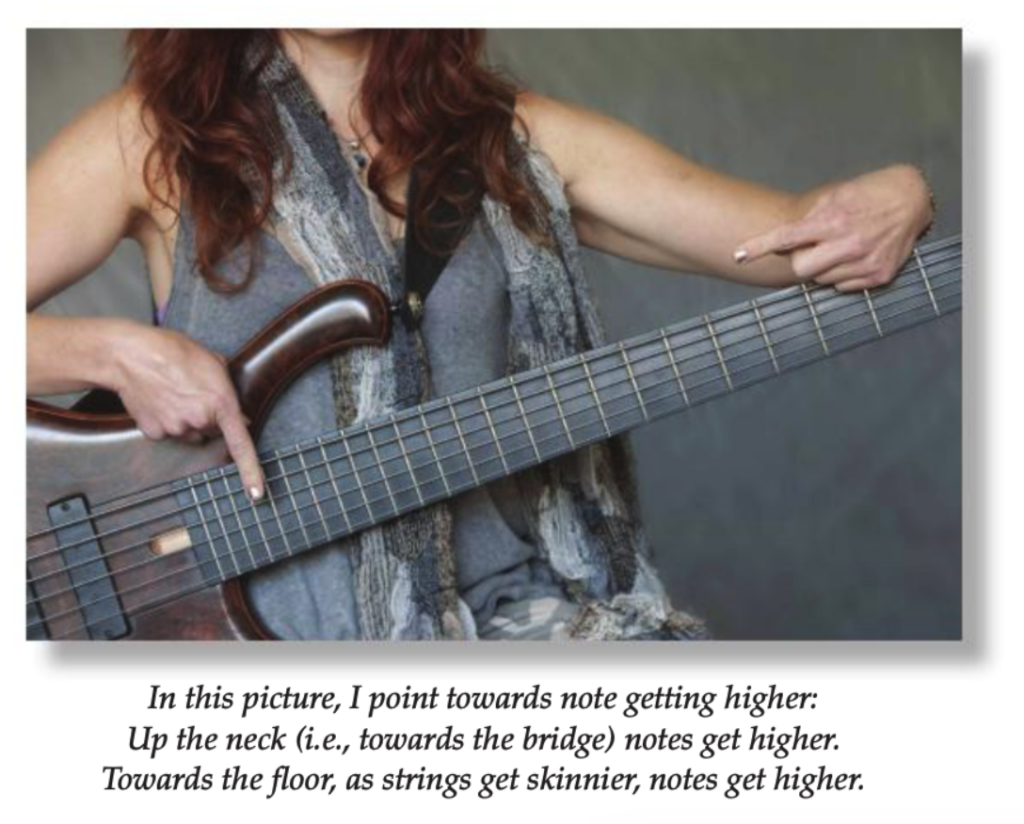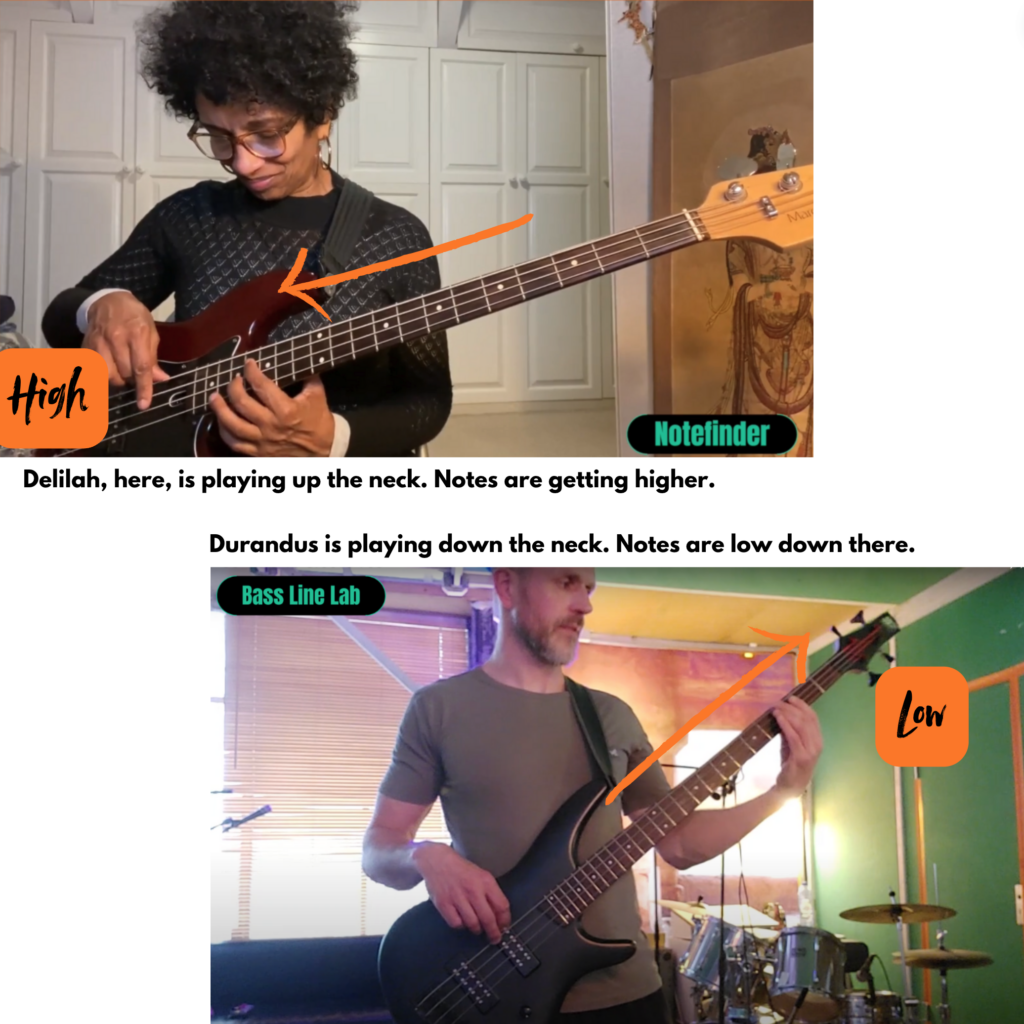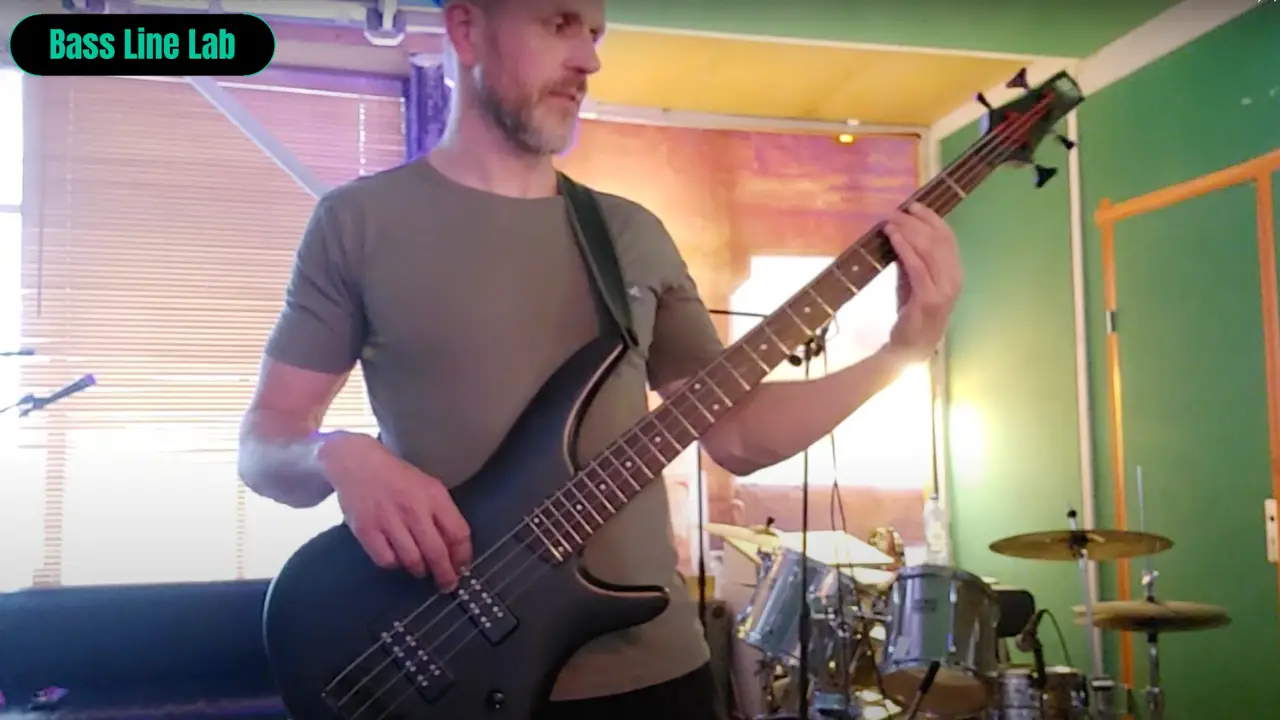Want to learn the Bass Guitar Notes?
- Bass Guitar Notes are easy to learn, but there is a trick to it:
The trick is to start by understanding the fretboard.
High and Low Bass Guitar Notes – not as easy as it looks!

- Notes get higher sounding the closer you get to the bridge.
- Notes get higher sounding as strings get thinner.
So, so far we have identified two directions on the bass where notes get higher:

One thing that understandably trips up beginners is that they should really say I play “UP THE NECK” when notes are sounding higher and “DOWN THE NECK” when notes are sounding lower. When musicians talk “high and low” they mean sonically, not in space. Our Music Theory Cohort students below demonstrate: it’s exactly the opposite as in space!

OK – so the above is true when staying on individual strings, but here is where it gets tricky.
When I start playing between strings, the direction can reverse… (go ahead and play these notes and listen:)

Notes are still getting higher (sounding) as I go towards the headstock:

Until I hit the same note:

And then they get lower (sounding), even though I am still going toward the headstock:

Though I am sure you’d agree that unless there is a good reason for this big jump, staying on the same string is much more economical here:

Same bass guitar note – many locations!
Of course, this is because bass guitar notes show up on the fretboard more often than just once: here for example, G:

Here, look at the same notes written out as TAB:

This is important to understand because it is unique to fretboard instruments such as the bass!
On the piano I have this same note only once:
 So how do you know when to use which one?
So how do you know when to use which one?
When you are just starting out and exploring the bass, it does not matter which one you use – it’s just important that you get used to finding them. As you keep progressing, you want to go beyond the single note hunt-and-peck method though.
This is because it’s actually harder to reinvent the wheel each time to find a note.
This is an immensely important point that beginners often miss: Music always happens inside a context – if you recognize the context (ie: keys, chords, scales) you will have a much easier time of it all!
So learning these contexts (AKA music theory, songs, grooves…) will make all this much more manageable.
So, that was a bit about the bass fretboard. Next, I’ll tell you about notes. And then I’ll show you a really cool drill!
How do notes work?
This is often where the image of a piano keyboard comes in handy because it is so conveniently color-coded:

You see the white and black keys
and you can easily see the closest distance between notes. The closest distance is called a “half step,” and on the piano, half steps are neighboring keys.
Half steps can occur between a white and black key (turquoise arrows show two examples) but also between certain white keys (E/F and B/C) – the pink arrows.
The bass is pretty neat for half steps, too, though, as it’s just neighboring frets on the same string:
 And whether the half step is between “white and white key” (pink) or “white and black key” (turquoise) – well, on the bass the shift just looks the same!
And whether the half step is between “white and white key” (pink) or “white and black key” (turquoise) – well, on the bass the shift just looks the same!
Note Names
The white keys are named by the letters A through G of the alphabet.
All of the white keys can be made higher by a half step which is done by adding a #:
C# D# E# F# G# A# B#
Some of these now turn out to be black keys (C# D# F# G# A#), but some are still white keys: E# and B#!

What goes up must come down, right?
Right!
If I want a note to sound a half step lower, I add a flat sign:
Cb Db Eb Fb Gb Ab Bb
Same deal, some are black keys: Db, Eb, Gb, Ab, Bb
Others are white keys: Fb, Cb
Find a few of these notes on the keyboard, to practice.
Multiple Personality notes
So, each note has a few names, then, with most having two names (D#/Eb or C/Cb), but some only one (G, A and D).
There is also another level of this “sharps” and “flats” business which is called double sharps and double flats, but you can leave that for another day. For now, just appreciate that each letter name can have a natural (no sharp or flat), sharp and flat version.
Notice that on the piano that is easy to see.
On the bass fretboard, not so much:
(not all note names are listed to keep it neat)
[this is an excerpt from our Music Theory for the Bass Player Wallchart, all rights reserved]

Bass Players need to know the note names
Naming notes is often not popular with bassists who use a lot of TAB. And I get it – the TAB tells you where to press by fret number and string, so it seems to be all that’s needed to learn a song. However, just like coloring by numbers, it won’t teach you to create your own bass lines.
Consider this: naming something is the first step to mastering it! That is definitely true for knowing where sounds are on the fretboard, how to communicate with others about them, and, most importantly, how to get what you hear inside “out” onto the fretboard!
Once you learn to name them and learn the ways they relate (“theory”), it’s like you can start using words and sentences to tell your own stories rather than only learn those from others by heart.
Let’s Practice on the Bass
What follows are two of our many signature drills to learn the notes. We have many, many more.
March up a string
Let’s march up the E string:
E F F# G G# A A# B C C# D D# E
Now go up the A string and see where the notes start catching up with each other:
A A# B C C# D D# E….

The sequence repeats! This is – by the way – called a chromatic scale – I am proceeding up the bass strings in half steps. I started on the E string and marked out some that would then repeat on the A string (and even on the D string). These sequences of course will repeat over and over.
PRACTICE TIP:
- March up your E string playing each note saying sharps – E F F# G G# etc – and then descend using flats: E Eb D Db C etc!
- When that gets easier go up using flats – E F Gb G Ab A etc – and down using sharps: E D# D C# C etc!
- Do this with every string of your bass!
There are many many more variations of this drill in my book “Music Theory for the Bass Player”. Do these often – they are gold and get easier fast. Spend a few minutes each day, short periods of time are best. Just five minutes! In a few days or weeks, those note names will become yours!
Awesome Bass Guitar Notes Drill: The NOTEFINDER
This drill is awesome: Find a certain note, let’s say G, on every single string. So, G on the E string, then A string, then D string, then the G string.
Mark down the fret numbers:
On the diagram you see that notes are either offset by 7 or 5 frets between strings. – that’s a good distance to get under your belt!

Pick a note a day and you will know the foundation of your bass guitar notes in no time. In our Courses we practice the notefinder in many fun variations, with improvisations, through the cycle, by using only certain fingers and more. It’s really fun, like a gigantic sudoku, just with strings and frets! Using a track while doing so makes it feel like a groove rather than a drill! In our Flagship Music Theory for the Bass Player Course, we drill every single note all across the fretboard, in a variety of different styles, meters and feels. And that’s just a small part of what we do there!
We have many more drills, but I will leave it there. Have fun exploring your fretboard, and make those bass guitar notes yours!

